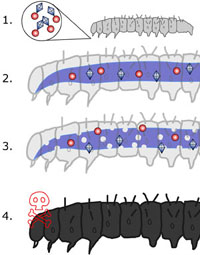Bacillus thuringiensis Overview
History of Bacillus thuringiensis
Bt Basics
Bt crystals - what are they and how do they work?
Bt crops
History of Bacillus thuringiensis
The bacterium Bacillus thuringiensis (Bt) was discovered independently by two different scientists at the beginning of the twentieth century. In 1901, Japanese biologist Shigetane Iswatari realized that Bt was responsible for killing the silkworms he was observing. Then in 1911, a German scientist Ernst Berliner identified Bt as a pathogen of Mediterranean flour moths, from the German state “Thuringia” (hence the name thuringiensis). (Aroian et al., 2004 and Deacon, 2004)Thus, Bt was then recognized as an organic insecticide, and was applied by some farmers to crops to resist pests. However, because Bt easily washed away in rain and degraded in sunlight, and was ineffective against many crops' pests (it was then considered toxic to only lepidopteran insects, or moths), Bt was less popular than other synthetic insecticides. Nevertheless, the U.S. Environmental Protection Agency (EPA) registered Bt as a pesticide in 1961. As resistance to synthetic insecticides developed and environmentalists began questioning the effects of such chemicals, the interest in Bt increased, along with funding for its research. (Aroian et al., 2004) Some Bt strains were also found to be effective against other species' larvae, including coleoptera (beetles) and diptera (flies/mosquitoes). (Deacon, 2004)
With the advent of genetic modification technology, scientists were able to incorporate the Bt genes that encode their toxins into the genetic material of plants, enabling the plant itself to kill its attackers.
(Want more information on genetic modification? See “Biotech Breeding Methods” on http://bio.davidson.edu/people/kabernd/seminar/2002/tech/howto.html )EPA registered the first genetically modified Bt crop, corn, in 1995, which protected corn crops from the European corn borer (Ostrinia nubilalis). Other Bt crops, including cotton and potatoes have since been introduced. (Aroian et al., 2004 and Deacon, 2004) Everything seemed to be going relatively smoothly for Bt crops until serious questions “cropped” up about its potential risks to non-target organisms, such as the monarch butterfly, in 1999.
Bt Basics
Bacillus thuringiensis is a bacterium that produces crystal proteins, which are toxic to many insect species. Bt is naturally found in small amounts throughout the world: in soil, beaches, deserts, and tundra. (Aroian et al., 2004) The thousands of different Bt strains are characterized by the different crystal proteins they produce, which in turn cause them to be toxic to different species of insects. Bacillus thuringiensis is a relative to Bacillus cerus, which produces the toxins that cause gastroenteritis (food poisoning) in humans. (Aroian et al., 2004) However, the crystal proteins produced by Bacillus thuringiensis are not harmful to humans, the reason for which is discussed below.
Back to top
Bt Crystals - what are they and how do they work?Bacillus thuringiensis produces insecticidal protein toxins that aggregate to form what are called Bt crystals. These crystals are insoluble in standard conditions, but will dissolve at high pH (>9.5). While no section of the human digestion tract has a pH so high, the mid-gut of some insects does, which explains why humans are not susceptible to the insect toxins. (Deacon, 2004). When the proteins of Bt crystals dissolve, they are cleaved by an enzyme in the insect's gut in order to become active. Once activated, the proteins interact with receptors on gut epithelial cells and insert certain domains of their structure (a-helices) into the cell membranes, creating pores. These pores allow ions to move freely across the cell membranes, disrupting the cells' natural ion gradients. (Deacon, 2004) The bacterium is then able to germinate its spores into the host's cells, and this invasion causes the host organism to die. (Aroian et al., 2004)
1. Insect larva eats the Bt spores and toxic crystal proteins2. At high pH in the insect's midgut, the crystal proteins dissolve and interact with epithelial cell receptors.
3. The crystal proteins create pores in the cell membrane, disrupting the cells' equilibria, and allowing the Bt spores to germinate into the host's cells.
4. Host organism dies from the invasion.
Diagram Courtesy of Raffi Aroian LabCrystal proteins are encoded by “Cry” genes on circular segments of DNA, called plasmids, within Bt. All the known Cry genes are classified and named with a number and letter, for example, Cry1A, Cry 8B, etc. Single Cry genes or combinations of Cry genes may be inserted into crop plants to develop plants resistant to specific insects. (Gatehouse et al., 2002) Because a single Bt strain may contain 5-6 plasmids encoding different toxins and these plasmids may also be exchanged between Bt strains, there is great potential for extensive toxicity combinations. (Deacon, 2004)
In investigating Losey et al.'s initial claim that Bt corn may be harmful to monarch butterfly larvae, researchers tested three commercial Bt-expressing corn constructs for their insecticidal effects on monarchs. The names of these different Bt corn constructs (also called “Events”) were Mon810, Bt11, and 176, and each included the Bt Cry1Ab gene (a subset of Cry1A). The difference between these Events was the promoter used to initiate the transcription, and thus expression, of the Cry1Ab gene within the Bt corn plant. Different promoters may induce greater expression of the Cry1Ab gene than others, explaining why the three commercial Bt corns yielded different test results. (Gatehouse et al., 2002) For the conclusions of these tests, see my Resolutions page.
Contact me: Leigh Anne Hoskins, lehoskins@davidson.edu
Last modified on 11 February, 2004
________________

